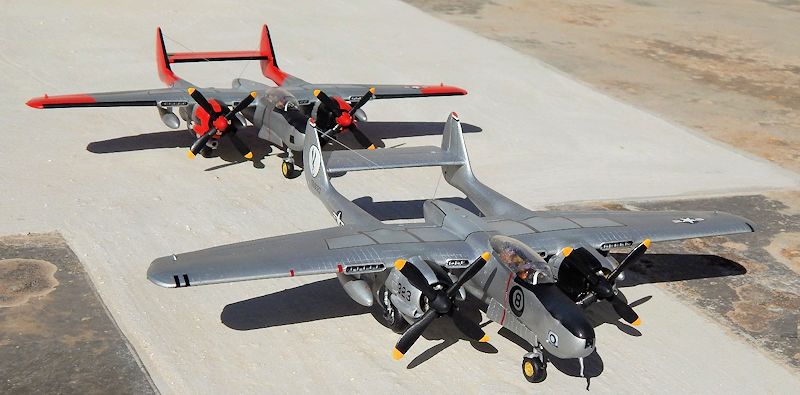
1/72 F-15 Reporter
| KIT #: | ? |
| PRICE: | ? |
| DECALS: | ? |
| REVIEWER: | Carmel J. Attard |
| NOTES: | Conversions |

| HISTORY |
 The F-15
Reporter was a descendant of the P-61 ‘Black Widow’. The P-61 was the first US
aircraft was specifically designed as a night fighter. It had a brief but
successful operational career both in Europe and the Pacific theatre before the
termination of World War II.
The F-15
Reporter was a descendant of the P-61 ‘Black Widow’. The P-61 was the first US
aircraft was specifically designed as a night fighter. It had a brief but
successful operational career both in Europe and the Pacific theatre before the
termination of World War II.
In July 1944 the Photographic reconnaissance design was commenced, having dual
controls under a tandem canopy and an adoptable fuselage to take anything up to
16 cameras. The original Double Wasp R-2800-65 engines were replaced by more
powerful R-2800-C engines, which in combination with a more streamlined fuselage
pod, gave a 70 mph increase over the Black Widow.
The F-15 was built for a crew of 2, seated in reclining
seats under a large single piece canopy. The rear seat was built with basic
flying controls, allowing the occupant to relieve the pilot if needed. The job
of the back seater was to control the cameras and navigate the aircraft. Both
crew were rated pilots and trained in the recon naissance
task, so they usually alternated their position during each flight.
naissance
task, so they usually alternated their position during each flight.
36 F-15A were produced, nine were allocated to Air Material Command in the US,
and the other 27 shipped to the 8th PRS in Japan.
At least three arrived in such a poor state that they were reduced to
spares and two were written off in service. The heavy maintenance and lack of
spare parts caused the P-61 very difficult to keep in the air. Some crewmen
commented that the aircraft were “held together with baling wire”. Several
factors included the advent of the jets such as the RF-80, led to the
cancellation of the contract in 1947 hence only 36 airframes were complete along
with two prototypes.
Production of the F-15A mostly utilized parts already produced for the P-61C,
cancelled in 1946. To go in line with the USAF redesignation
of all its aircraft types, the F-15A became the RF-61C since the F-15 was based
on the P-61C airframe. The surviving F-15s were flown into storage at Tachikawa
and most were scrapped. A small number were returned to the USA.
Following limited use by NACA and in Project Thunderstorm, the Reporter (and the
Black Widow) was declared
obsolete in 1952. One aircraft joined the civil register and survived until
1968, when it was lost in an accident while fire-bombing.
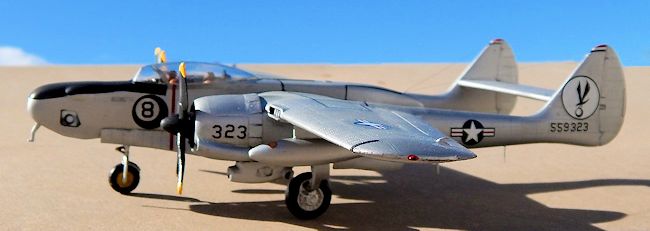 While
attached to the 8PRS 71st recon Gp, Itazuke, Japan in 1948 the F-15
Reporter performed several important tasks. This involved the Post Hostilities
Mapping Program, together with F-13 (B-29) units. A major task was photo mapping
the Korean Peninsula, the result of which proved vital when war broke out there
in 1950.
A detachment of F-15As including the aircraft 45-59323 was assigned the area of
the Philippines and Celebes under the 5th Reconnaissance Group of the
13th Air Force, and their mission included mapping the route to the
Bataan Death March for war crimes prosecutors.
While
attached to the 8PRS 71st recon Gp, Itazuke, Japan in 1948 the F-15
Reporter performed several important tasks. This involved the Post Hostilities
Mapping Program, together with F-13 (B-29) units. A major task was photo mapping
the Korean Peninsula, the result of which proved vital when war broke out there
in 1950.
A detachment of F-15As including the aircraft 45-59323 was assigned the area of
the Philippines and Celebes under the 5th Reconnaissance Group of the
13th Air Force, and their mission included mapping the route to the
Bataan Death March for war crimes prosecutors.
Up to 6 cameras of 17 different types could be fitted in the compact camera nose
of the Reporter which added 9” to its length over that of XP-61E on which it was
based.
| THE KIT |
| CONSTRUCTION |
For a long time the F-15 Reporter has been on the list of kits that I wanted to
make. Two P-61 Black Widows were ready to be converted into Reporters, one using
the Airmodel set and the other the resin Lone Star conversion set.
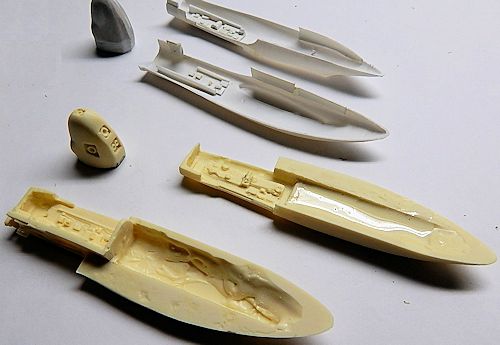
The first kit to build was the F-15 with Airmodel vac fuselage. The fuselage
halves were first prepared and the nose wheel well cut and scratch built with
all the details copies of the LSM resin kit. Wheel well detail and cockpit
detail all added so that I finish with two Reporter fuselage sets. I had spare
set of crew seats,
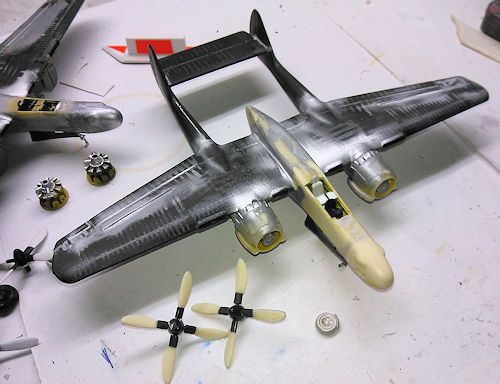 instruments
and all other detail made from plastic card and stretch sprue. Fortunately I had
a metal SAC set for one of the models. The other set I used the Airfix u/c legs,
but replaced the nose wheel as the kit one was too small. It is here that I
realized what huge advantage the SAC set offered over the plastic one. I broke
the flimsy plastic wheel legs several times during the process of building,
converting and paintwork and had the tedious job of fine drilling and implanting
metal wire to save the plastic set.
instruments
and all other detail made from plastic card and stretch sprue. Fortunately I had
a metal SAC set for one of the models. The other set I used the Airfix u/c legs,
but replaced the nose wheel as the kit one was too small. It is here that I
realized what huge advantage the SAC set offered over the plastic one. I broke
the flimsy plastic wheel legs several times during the process of building,
converting and paintwork and had the tedious job of fine drilling and implanting
metal wire to save the plastic set.
The wing wheel wells were also further detailed, as those on the Airfix kit were
bare. One has to mention here that the Airmodel fuselage had to be extended 3/8”
to the forward nose area just ahead of the wind screen so that it was now of
same length as the resn one which seem to conform with the side views shown in
Aviation News V16, No6. Issue. The Airmodel fuselage was also corrected by
building up with putty to the rear fuselage by 3/16”. Two camera fairings were
also built up to the upper sides of nose area. The nose antenna differed from
that of the Black Widow and was kinked to conform to side view. In the Airmodel
kit, slots were cut in wing root to match the Airfix kit wing. With resin
fuselage kit I drilled two dowel holes and added dowels to the Airfix wings
instead of using the wing prints to take slots. The canopy was in each case cut
with scissors then gently trimmed to correct sit on the cockpit by trimming
little at a time with a sharp exacto blade. The canopy was fixed with Klear
liquid once the interior was painted.
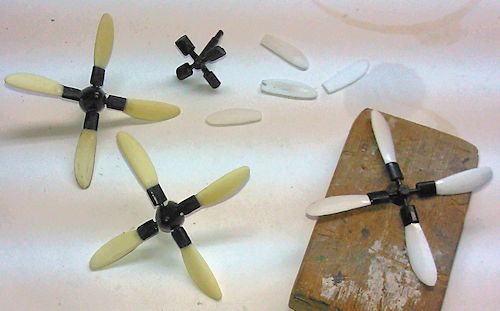 The LSM
resin kit fuselage and parts practically all that was required was little
cleaning and drill a hole to take the nose wheel which came from the Airfix kit
but which needed a mud guard in same design as the SAC nose leg. The cowling
exhaust port outlet was drilled a little deeper. In one kit I had to scratch
build the wider chord propeller tips to same size as the resin offering. The
Airfix propeller hub was also increased in length by ading a 1/16” thick ring at
the base.
The LSM
resin kit fuselage and parts practically all that was required was little
cleaning and drill a hole to take the nose wheel which came from the Airfix kit
but which needed a mud guard in same design as the SAC nose leg. The cowling
exhaust port outlet was drilled a little deeper. In one kit I had to scratch
build the wider chord propeller tips to same size as the resin offering. The
Airfix propeller hub was also increased in length by ading a 1/16” thick ring at
the base.
One should mention here that the LSM kit comes with a complete set of superb
decal sheet to make any two of the Reporters built. Decal sheet is packed with
registration numbers, of different size, star and bars with separate bars in the
event the prototype is selected, walk way black lines, different nose and tail
art etc. My fancy for the Airmodel converted F-15 fell on 559300 which carried
bright red Arctic markings to the tail unit, wing tips and engine cowl front.
This conformed to T.O.1-1-4 and it stands to reason that it also had black
de-icing boots to wings and tail fins leading edges.
| COLORS & MARKINGS |
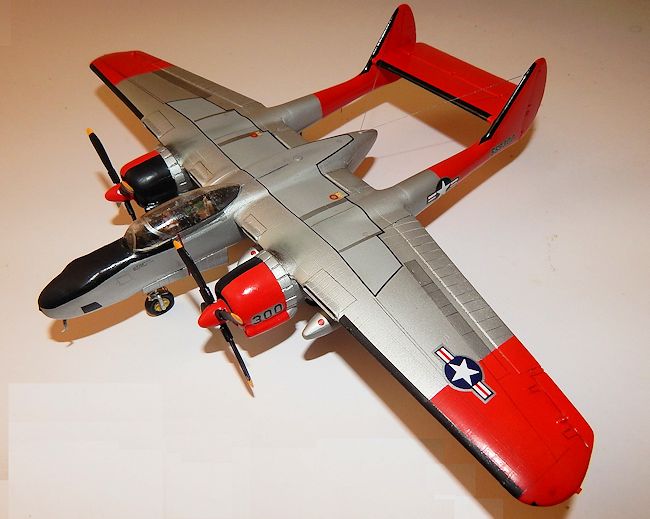
| CONCLUSIONS |
 Both the LSM
resin kit and SAC metal legs were not intended to go on the Airfix kit but for
the DML. In both cases these went equally well with the Airfix kit of the Black
Widow. I should say that the LSM kit was the better conversion set out of the
two. Anyone who enjoys conversion kits will find great satisfaction in making a
Reporter. It was not a type with an
eventful service history but the graceful design of the Reporter should appeal
too many.
Both the LSM
resin kit and SAC metal legs were not intended to go on the Airfix kit but for
the DML. In both cases these went equally well with the Airfix kit of the Black
Widow. I should say that the LSM kit was the better conversion set out of the
two. Anyone who enjoys conversion kits will find great satisfaction in making a
Reporter. It was not a type with an
eventful service history but the graceful design of the Reporter should appeal
too many.
| REFERENCES |
If you would like your product reviewed fairly and fairly quickly, please contact the editor or see other details in the Note to Contributors.